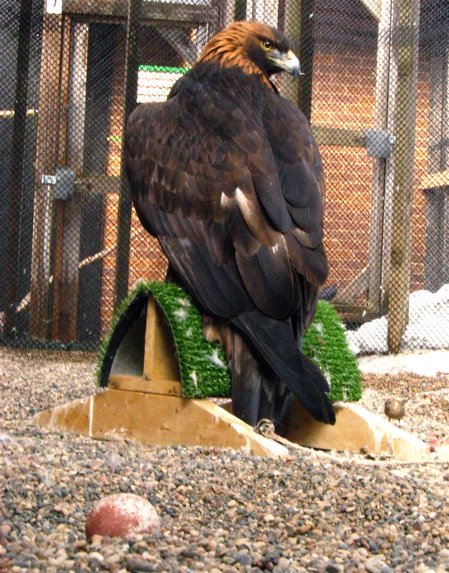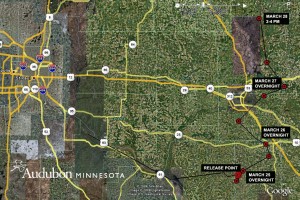My buddy, Mark Martell who works for Audubon Minnesota is working on a project with the National Eagle Center, the Minnesota Department of Natural Resources Nongame Program, and the Wisconsin Department of Natural Resources – Endangered Resources Program studying golden eagles wintering along the Mississippi River.

Golden eagles do not breed in Minnesota and Wisconsin and have not been considered regular users of the Mississippi River during the winter, but in the last few years, there have been several reports, especially near the Wabasha area. The National Eagle Center organized a volunteer survey program and have counted as many as 60 golden eagles using the coulees and bluffs along the Mississippi River from Red Wing, MN to LaCrosse, WI. This wintering population does not mix with the much larger and better known population of wintering and breeding bald eagles found in the same area. I actually got to see one of the golden eagles last winter whenn I went out with Joan from the Eagle Center.
Many who have counted the golden eagles wonder, where are these birds coming from? They could be breeding in Canada and the size of the breeding population in northern Ontario is thought to be small and thus vulnerable. If the birds are moving from western breeding areas they could be severely impacted by wind generator projects proposed for the Great Plains and western Minnesota.We need to find out where they go and what their migratory route is.
One of the ways they are going to do that is by putting satellite transmitters on golden eagles. This winter, a golden eagle that was found injured in a coyote trap (a nice name for a leg-hold trap--can't we ban those types of traps please) on the Wisconsin side of the Mississippi River where the golden eagles are wintering. It was treated at The Raptor Center and was released on March 25, 2009. When the bird was let go, Mark was able to attach a transmitter and given the name, Golden Eagle 42. You can read about it and watch video on MPR or the Star Tribune.
While in Indianapolis, I got this email update:
"After its release the bird spent the evening of the 25th near its release point then began moving north. By the evening of the 28th it was in northern Chippewa County (Wisconsin)."
 If this map is hard to read, just click on it and you can see a larger version.
If this map is hard to read, just click on it and you can see a larger version.
"On the attached map the release point and evening stopover sites are noted by a circle and text. Circles not marked with text are other points were the bird was tracked in between those times. The black line indicates the shortest route between known points where the bird was, but we cannot be sure the bird actually took that route."
Maps and other information will be posted on the Audubon Minnesota website, their goal is to update every 3 days as the birds makes its way north. I'll add links and updates here and on Twitter as I get them.
